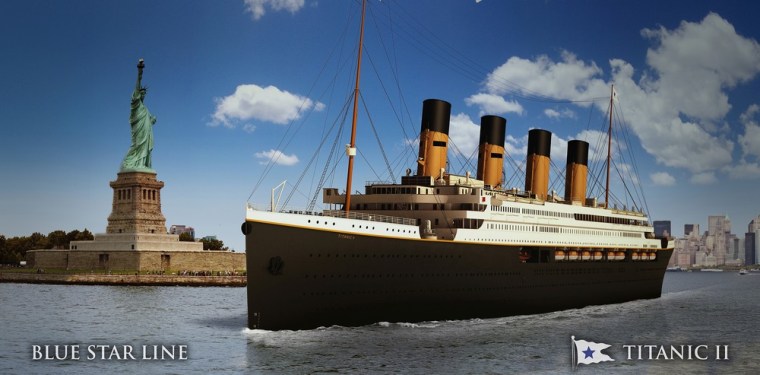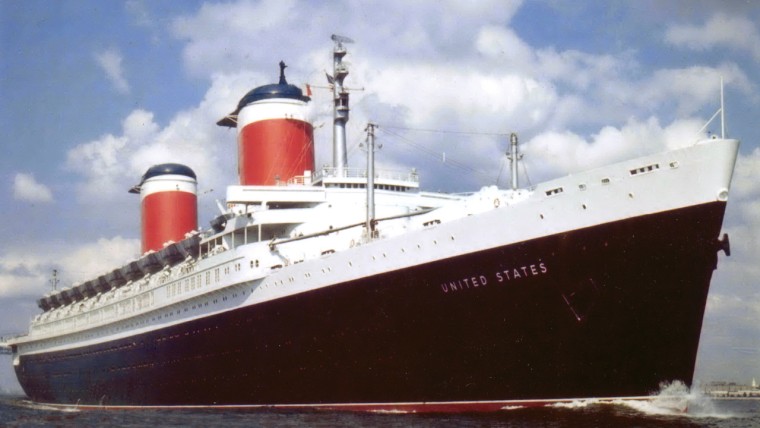Just over a century after the Titanic sank to the bottom of the North Atlantic, an Australian billionaire has officially floated plans to build a successor.
On Tuesday, Clive Palmer, chairman of Brisbane-based Blue Star Line, revealed blueprints for Titanic II, a “full-scale re-creation” of the illustrious, if ill-fated, ship at a press conference on the Intrepid Air, Sea & Space Museum in New York.
Set to sail in 2016, the ship is one of several — the QE2 and SS United States are among the others — that seek, in one or way or another, to recapture the glory days of the great ocean liners and ensure that their legends live on.

First up: Titanic, or more precisely, Titanic II, a modern-day version of the ship that sank on its maiden voyage in April 1912. During today’s press conference, Palmer referred to the original as a “ship of dreams” and its successor as a ship “where dreams come true.”
As envisioned, that dream entails building an 883-foot-long, 55,800-ton vessel with space for 2,435 passengers. That’s small by today’s standards — the Queen Mary 2 measures 151,000 tons; the Oasis of the Seas, 220,000 tons — but big enough to offer a casino, gymnasium and other features reminiscent of the original.
In other nods to the past, passengers will wear period clothing from 1912 and be able to book passage in first, second or third class.
"It will be 98% the same," Palmer told the BBC last year. Presumably, the other 2% will apply to the welded (not riveted) hull, the modern propulsion system and the addition of enough lifeboats to preclude problems with things that go bump in the night at sea.
While Palmer declined to discuss the cost of the ship, other ocean liner aficionados have expressed doubts about the viability of the project ever since the idea was first floated last year.
“It’s like a Disneyland representation of the Titanic,” said maritime historian Peter Knego. “You can’t build with wood anymore, you can’t rivet, you can’t do all the things that made the Titanic what she was.”
Nor, says Knego, can you ignore the fact that the vast majority of today’s cruisers prefer ships with waterparks, climbing walls and other resort-style amenities. By comparison, interest in transatlantic crossings, like the ones Titanic II is expected to begin making in 2016, went into sharp decline the moment Pan Am and BOAC began flying jets across the pond in 1958.
“There’s probably a couple thousand people in the world who’d be fascinated by a transatlantic crossing on a replica of the Titanic,” Knego told NBC News. “It would also have to compete against the Queen Mary 2 and there are times that the QM2 isn’t even full.”
Original ships, alternative uses
While Titanic II seeks to turn back the clock to the glory days of the ocean-liner era, proof that time doesn’t stand still sits, rusting and peeling, at a dock in Philadelphia. Originally launched in 1952, the SS United States was as famous in its day as the Titanic was 40 years earlier but without the morbid associations.
“It’s the most famous ship that didn’t sink,” said Susan Gibbs, executive director of the SS United States Conservancy, which seeks to preserve the vessel. “It’s still with us and is by many accounts one of the most storied U.S. liners ever built.”

That story, much condensed, goes like this: Entering transatlantic service in 1952, the ship immediately became the unofficial flagship of the U.S. fleet, recognizable for its knife-like bow and red, white and blue funnels. She broke the transatlantic speed record on her maiden voyage and holds the westbound record for fastest passenger service to this day.
“When she was built, she represented the country,” said Knego. “People were aware of her like they’re aware of the space shuttle now.”
Alas, the subsequent rise of transatlantic jet service essentially killed the market for transatlantic sailings and the ship was taken out of service in 1969. Since then, it’s had several owners, been stripped of its fittings and avoided several dates with the scrapyard.
Since 1996, the ship has sat at the dock in Philadelphia, its hull streaked with rust and its red, white and blue funnels faded to shades of pink and gray. The good news is that the ship is structurally sound and asbestos-free; the bad news is that carrying costs (maintenance, insurance, etc.) average $75,000 per month.
“That’s a heavy lift and one that can’t be borne indefinitely,” said Gibbs, who, it turns out, is the granddaughter of the ship’s designer, William Francis Gibbs. Scrapping the ship remains a threat, “but everyone involved will work their hearts out to avoid that fate,” she told NBC News.
Those efforts include a grassroots campaign called SaveTheUnitedStates.org and and plans to turn the ship into a waterfront attraction with hotels, retail outlets and a museum dedicated to the ship, 20th century design and the American ingenuity that underscored it.
According to Gibbs, discussions have been undertaken with several municipalities that might host the ship with New York being the most likely venue: “It was the ship’s homeport during its service career; it attracts a lot of tourists, and it’s a bustling city with high hotel occupancy rates.”
The effort would not come cheap but it’s also not without precedent. The first Queen Mary has been a dockside hotel/tourist attraction in Long Beach, Calif., since the early 1970s, although, it, too, has faced a series of financial setbacks.
More recently, the Queen Elizabeth 2, or QE2, which has been sitting idle in Dubai since 2008, was sold to Oceanic Group, a Singaporean company that plans to turn it into a hotel/attraction in an as-yet-unnamed Asian city.
Given the above, it’s clear that these grand old ships have incredible appeal just as there’s no denying that their futures are marked by ocean-liner-sized question marks. For Clive Palmer, it’s about recapturing the essence of one iconic vessel; for Susan Gibbs, it’s about ensuring that the essence of another isn’t lost forever.
For his part, Peter Knego has his own wish: “For people who appreciate classic skyscrapers and old movie theaters, scrapping the United States would be like demolishing the Empire State Building,” he told NBC News. “ If only (Palmer) would invest in the ship instead of recreating one that never completed its maiden voyage ...”
Rob Lovitt is a longtime travel writer who still believes the journey is as important as the destination. Follow him at Twitter.